January 21, 2022
The Chicago Transit Authority (CTA) released a $3.5 billion, five year FY2022-FY2026 capital plan in October 2021. The CTA prepares a multi-year, comprehensive capital improvement plan (CIP) at the same time as its annual operating budget. It is included in the operating budget book. The first year of the CIP is the capital budget for that fiscal year.
The CTA capital budget for FY2022 is projected to be nearly $1.1 billion. This an 8.1%, or $80.9 million, increase from the original FY2021 capital budget of $995.4 million.[1]
The CTA acknowledges that the ongoing COVID-19 pandemic will continue to impose challenges to the future operations and fiscal solvency of the agency. Ridership in 2021 grew to about half of pre-pandemic levels, or approximately 750,000 average weekday rides. Ridership is expected to increase in 2022, but it will likely remain below historic levels. A full recovery for the CTA is contingent in large part on a return to pre-pandemic levels of business activity as well as Chicagoans resuming their normal lifestyle routines. Like other U.S. transit agencies, the CTA has continued to maintain service throughout the pandemic due to federal financial support from the Coronavirus Aid, Relief, and Economic Security (CARES) Act, Coronavirus Response and Relief Supplemental Appropriations Act (CRRSA) and the American Rescue Plan Act (ARPA).
CTA Capital Plan
The CTA has identified a total of $29.0 billion in long-term capital project needs. A breakdown of those needs includes:
- $11.8 billion to maintain infrastructure and facilities in a state of good repair;
- $8.6 billion for modernization projects; and
- $8.8 billion for expansion projects.[2]
The five-year capital plan for FY2022-FY2026 proposes a total of nearly $3.5 billion in funding to address the CTA’s capital needs. Of that amount:
- Federal funds will account for 58.73% of all funding, or $2.0 billion;
- Funding from the State of Illinois will provide $696.7 million in motor fuel tax pay-as-you-go funding. These State funds come from the Rebuild Illinois Capital Plan approved by the General Assembly in 2019;[3]
- CTA bond funds and ground transportation tax receipts will fund approximately $736.6 million in projects; and
- A small amount, roughly $525 million, will come from competitive grant funds.
The CTA anticipates receiving additional funding from the federal Infrastructure Investment and Jobs Act approved in November 2021 which includes $109 billion for mass transit systems across the nation.[4]

CTA capital funding by use in FY2022 is projected to total $1.07 billion. In this year:
- Bond financing costs will total $332.0 million, or 30.8%, of total spending;
- Rail line modernization and improvement projects will use $274.6 million, or 25.5%, of all spending;
- Support facilities and equipment will use $132.1 million;
- Rail rolling stock projects will spend $124.9 million, or 11.6%, of FY2022 funding;
- Bus rolling stock projects will use $83.1 million, or 7.7%;
- Approximately $63.4 million, or 5.9% of all spending, will be used for rail power and way projects; and
- Other miscellaneous funding uses include $66.0 million. This category includes information technology projects, equipment and vehicle replacement, security and communication projects, rail stations rehabilitation and capital improvement plan management.
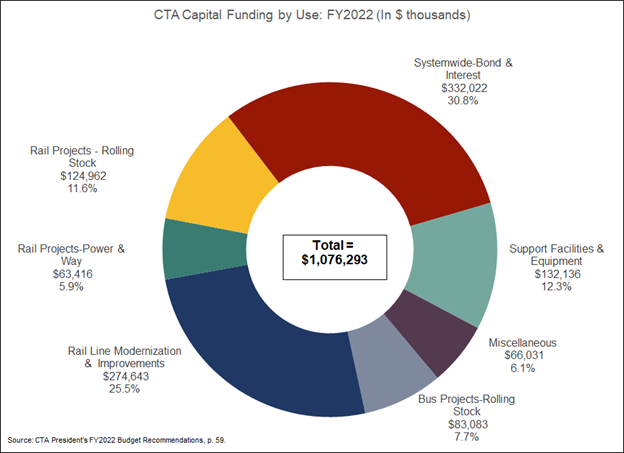
A five-year breakdown of CTA capital funding between FY2022 and FY2026 is shown next. System-wide bond financing costs will be the biggest use of funds, at $1.1 billion, or 31.6%, of the five-year total of nearly $3.5 billion. Rail line modernization and improvement projects will use $702.6 million, or 20.2%, of the total. This will be followed by rolling stock for bus projects at $501.0 million and rail rolling stock projects at $499.6 million.
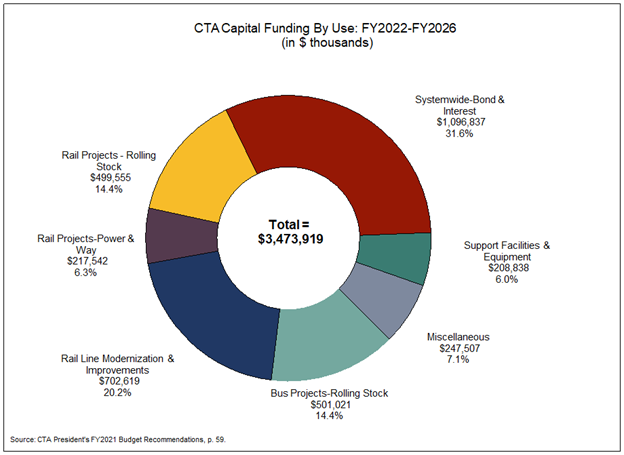
CTA Debt Service Trends
The CTA pays for debt service associated with pension obligation bonds and capital debt secured by federal Transportation Infrastructure Finance and Innovation (TIFIA) loans and Chicago ground transportation tax proceeds from its operating budget.[5] Other debt issues are paid for through the capital budget. Between FY2018 and FY2022, TIFIA and pension obligation bond debt service as a percentage of operating appropriations is expected to average 8.0%, which is below the range of 15% to 20% considered high by the rating agencies.[6]
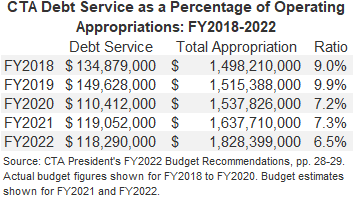
CTA Long-Term Obligations
CTA’s total long-term debt obligations as of December 31, 2021 include sales and transfer tax receipts revenue bonds, sales tax receipts revenue bonds, capital grant receipts revenue bonds,[7] capital lease obligations, building revenue bonds, and federal Transportation Infrastructure Finance and Innovation (TIFIA) loans. The security pledges for the outstanding debt issues are shown below.
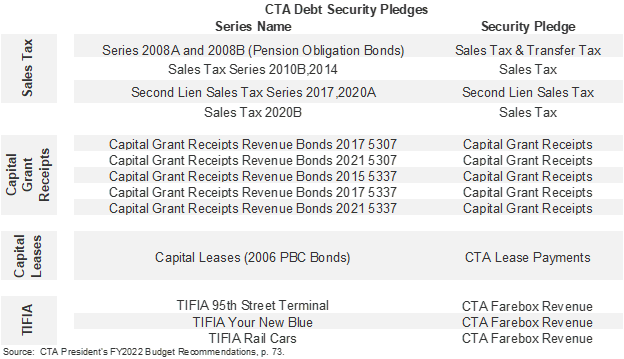
CTA 2021 and 2020 Bond Issues
In June 2021, the CTA issued $120.9 million in capital grant receipts refunding series bonds. Of that total amount, $99.3 million were backed by a pledge of Federal Transit Administration Section 5307 Urbanized Area Formula Funds and approximately $21.7 million were backed by Section 5337 State of Good Repair Formula Funds. The bond proceeds were earmarked to pay for refunding a portion of outstanding 5307 and 5337 bonds. 5307 bonds are secured by the Federal Transportation Administration’s (FTA) Urbanized Area Formula Funds and 5337 bonds are secured by the FTA’s State of Good Repair Formula Funds.[8]
In 2020, the CTA issued a total of $901.9 million in revenue bonds. Of that amount:
- $367.9 million was issued in second lien sales tax receipts revenue bonds (Series 2020A). These funds are primarily to be used to be used to finance capital projects and refund a portion of the second lien sales tax receipts capital improvement notes;[9] and
- $534.0 million was issued in taxable sales tax receipt revenue refunding bonds (Series 2020B). These funds will primarily be used to refund outstanding sales tax bonds.[10]
CTA Credit Ratings
The CTA’s outstanding debt was assigned the following ratings as of December 31, 2021.
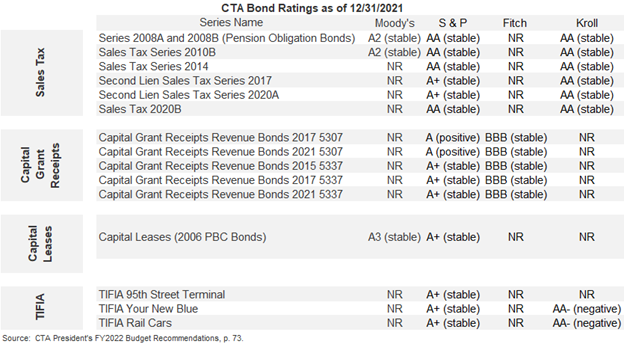
Rating Agency Actions in 2021 and 2020
In May 2021 Fitch Ratings assigned a BBB rating with a stable outlook to the CTA’s capital grant receipts refunding series bond issue. It also reaffirmed its BBB rating with a stable outlook for the Authority’s outstanding $363.6 million in capital grants receipts revenue bonds. The rationale for the ratings were that the federal government traditionally has provided the funding necessary to pay for this type of debt.[11]
Standard and Poor’s (S&P) Global Ratings revised the outlook to positive from stable and affirmed its A rating on the CTA’s outstanding 5307 capital grant revenue receipts bonds, refunding series 2017 in May 2021. It assigned an A+ rating with a stable outlook to the outstanding and new 5337 capital grant revenue receipts bonds. Finally, S&P assigned an A rating with a positive outlook to the new 5307 capital grant revenue receipts bonds, refunding series 2021. The outlook was changed due to reflect the likelihood that Congress will continue to provide adequate funding for the capital grants program.[12]
On May 20, 2021, S&P Global Ratings affirmed its AA credit rating for the CTA’s senior lien sales tax revenue bonds and revised the outlook to stable from negative. It also affirmed its A+ rating on outstanding second lien sales tax revenue bonds. The change in outlook was due to two factors: 1) the CTA’s receipt of substantial American Rescue Plan funds has improved the Authority’s liquidity position and 2) because sales tax revenues have been adequate to support debt service coverage.[13]
Earlier, in late March 2020 Standard and Poor’s Global Ratings had revised its credit outlook for many U.S. transit agencies including the CTA to negative from stable due to the negative economic and revenue impact of the coronavirus pandemic. This impacted the CTA’s sales tax and senior lien sales tax bond issues.[14]
Standard and Poor’s Global Ratings affirmed its A+ rating on TIFIA loans, the A+ rating on Public Building Commission of Chicago bonds backed by CTA capital lease payments on April 30, 2020. The CTA’s stand-alone credit profile remained A+ with a negative outlook. The ratings reflected S&P’s view that the CTA would be able to implement measures to maintain the current credit rating such as expense reductions and the deferral of capital spending.[15]
In July 2021 Moody’s Investors Services upgraded CTA sales tax revenue bonds to an A2 rating from A3. The outlook for these bonds was also revised to stable from negative. The upgrade reflected improvements in the credit position of the State of Illinois and the Regional Transportation Authority. A key reason for the upgrade is that sales tax revenues, which support the bond payments, have been resilient.[16]
In May 2020, Moody’s Investors Services affirmed its A3 credit rating on the CTA’s sales tax bonds while changing the outlook to negative from stable. At the same time Moody’s also affirmed the A3 rating on the CTA’s grant receipts bonds and the Baa1 rating on Public Building Commission of Chicago bonds backed by CTA capital lease payments, but changed the outlook for both issues to negative from stable. The reason for the change in outlook was the serious reduction in economic activity and transit ridership brought about by the COVID-19 pandemic that has negatively impacted revenues.[17]
Fitch affirmed its BBB credit rating for the CTA’s grant receipts bonds on May 28, 2020. The revenues for these bond anticipation notes are provided by the federal surface transportation funding program which has traditionally been a stable funding source.[18]
CTA Capital Improvement Plan
According to best practices for capital budgeting, a complete capital improvement plan (CIP) includes the following elements:[19]
- A comprehensive inventory of all government-owned assets, with description of useful life and current condition;
- A narrative description of the CIP process including how criteria for projects were determined and whether materials and meetings were made available to the public;
- A five-year summary list of all projects and expenditures by project that includes funding sources for each project;
- Criteria for projects to earn funding in the capital budget including a description of an objective and needs-based prioritization process;
- Publicly available list of project rankings based on the criteria and prioritization process;
- Information about the impact of capital spending on the annual operating budget for each project;
- Annual updates on actual costs and changes in scope as projects progress;
- Brief narrative descriptions of individual projects, including the purpose, need, history and current status of each project; and
- An expected timeframe for completing each project and a plan for fulfilling overall capital priorities.
Once the CIP process is completed, the plan should be formally adopted by the governing body and integrated into its long-term financial plan. There should be opportunities for public input into the process. A well-organized and annually updated CIP helps ensure efficient and predictable execution of capital projects and helps efficiently allocate scarce resources. It is important that a capital budget prioritize and fund the most critical infrastructure needs before funding new facilities or initiatives.
The checklist that follows assesses how well the CTA’s CIP conforms to best practice guidelines. It is important to note that the CTA develops its CIP in accordance with guidelines established by the Regional Transportation Authority (RTA). The annual RTA budget includes
five-year capital program information for CTA, Metra and Pace, the three service boards it oversees. The information RTA provides includes:
- Five-year summaries of capital program expense by category for the CTA, Metra and Pace;
- A discussion of capital impact on operations;
- A discussion of the amount of capital funds available for the RTA’s ten-year plan; and
- A discussion of capital impact on maintenance operations.
The CTA CIP, as published in its annual budget, conforms to most best-practice guidelines. This includes a detailed description of the CIP process, a CIP development timeline and a discussion of strategic and tactical decision support processes in the budget book.[20]

[1] CTA President’s FY2021 Budget Recommendation p. 59 and CTA President’s FY2022 Budget Recommendation p. 52.
[2] CTA President’s FY2022 Budget Recommendation, p. 56.
[3] CTA President’s FY2022 Budget Recommendation, p. 51.
[4] H.R. 3684 - Infrastructure Investment and Jobs Act at https://www.congress.gov/bill/117th-congress/house-bill/3684/text
[5] CTA President’s FY2022 Budget Recommendation, p. 34.
[6] Standard & Poor’s, Public Finance Criteria 2007, p. 64. See also Moody’s Investors Services, General Obligation Bonds Issued by U.S. Local Governments, October 2009, p. 18.
[7] These are Grant Anticipation Revenue Vehicles, known as GARVEE Bonds, that are issued in anticipation of receiving federal funds at a later date. See California Transportation Commission, “Grant Anticipation Revenue Vehicles Bond Financing (GARVEE) Bond Financing” at https://catc.ca.gov/programs/grant-anticipation-revenue-vehicles-bond-financing.
[8] Chicago Transit Authority, Official Statement: $120,975,000 Capital Grants Receipts Revenue Bonds, June 2, 2021, p. 1 and CTA President’s FY2022 Budget Recommendations, p. 77.
[9] Chicago Transit Authority, Official Statement: $367,895,000 Second Lien Sales Tax Receipts Revenue Bonds Series 2020A, August 27, 2020, p. 1.
[10] Chicago Transit Authority, Official Statement: $534,005,000 Sales Tax Receipts Revenue Refunding Bonds Series 2020B (Taxable), August 27, 2020, p. 1.
[11] Fitch Ratings, Fitch Assigns Chicago Transit Auth’s new GARVEE issuance ‘BBB’ May 19, 2021 at https://www.fitchratings.com/research/infrastructure-project-finance/fitch-assigns-chicago-transit-auth-new-garvee-issuance-bbb-19-05-2021.
[12] S&P Global Ratings, Chicago Transit Authority Section 5307 Urbanized Area Formula Funds Bond Outlook Revised To Positive On Higher Coverage, May 18, 2021 at https://disclosure.spglobal.com/ratings/en/regulatory/article/-/view/type/HTML/id/2649776.
[13] S&P Global Ratings. Chicago Transit Authority, IL Senior- And Second-Lien Sales Tax Receipt Revenue Bond Outlooks Revised To Stable, May 20, 2021 at https://disclosure.spglobal.com/ratings/en/regulatory/article/-/view/type/HTML/id/2652064.
[14] S&P Global Ratings, Mass Transit Agencies’ Priority Lien Revenue Bond Outlooks Revised to Negative on Anticipated COVID-19 Pressures, March 27, 2020.
[15] S&P Global Ratings, Chicago Transit Authority Debt Rating and ICR Affirmed at A+ on Efforts to Maintain Financial Metrics, April 30, 2020
[16] Moody’s Investors Services, Rating Action: Moody’s upgrades Chicago Transit Authority (IL) sales tax revenue bonds to A2 from A3; outlook revised to stable, July 9, 2021.
[17] Moody’s Investors Services, Rating Action: Moody’s affirms Chicago Transit Authority’s sales tax revenue bond rating at A3, revises outlook to negative, May 8, 2020.
[18] Fitch Ratings, Rating Action Commentary: Fitch Affirms US Municipal Standalone GARVEE Ratings. May 28, 2020.
[19] National Advisory Council on State and Local Budgeting Recommended Practice 9.10: Develop a Capital Improvement Plan, p. 34; Government Finance Officers Association, Best Practices, Development of Capital Planning Policies, October 2011.
[20] CTA President’s FY2022 Budget Recommendation, pp. 55-56.
